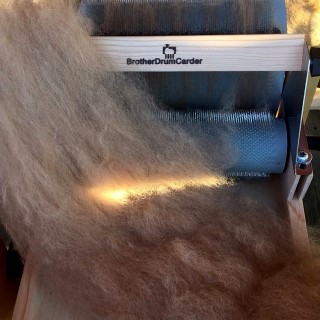Welcome Guest! Would you like to log yourself in? |
||||||||
| Home | About Us | Carders and Accessories | FAQ's | Using a Carder | ||||
| Carder Repair | Contact Us | Testimonials | My Account | My Cart | ||||
Using a Carder
| ||||||||
|
Watch our video to get started with your Brother Drum Carder. | ||||||||
|
Watch our video on how to card on a Little Brother Motorized Carder. | ||||||||
|
Watch our video to Use a Brother Cottage Carder. | ||||||||
|
Watch our video to Use a Brother Power Picker. | ||||||||
|
Watch our video to Use a Brother Rover. Go To Our YouTube Channel For More Videos! Click Here |
||||||||

Getting Ready to CardA drum carder works best if you feed it a small amount of fiber at a time - or, better yet, thin layers of fiber. If you attempt to feed a carder too much fiber at once, you may jam the machine, bend its teeth and/or tear the fibers. With wool and other fairly long fibers, this means that it's usually a good idea to start by fluffing up the fibers to eliminate thick clusters. Many spinners use a picker in this time consuming but important process, while others open the clusters of fiber by hand. Both of these methods work well. The First RoundAs with hand cards, we consider the first carding round to be a preparatory step, and I let the equipment do the teasing. Because the main objects of teasing are to prevent damage to the fiber and the card clothing, to promote a smoother end product, and to make carding easier, here's how to tease without working yourself into a lather. Instead of feeding unteased fibers through the feeding chute - where jams often occur - lay them directly onto the main drum from the top, where you can see what is happening at every Grasp a small handful of fiber or a couple of good-sized locks. Hold them firmly, and allow a few fibers to begin catching in the teeth as you turn the drum. Let the fibers be pulled gradually from your hand, being careful to keep your knuckles away from the teeth. (The fibers will not feed in gradually if the wool has been abused in washing, and has become tangled or felted so that it is hard to pull apart.) It's alright if a small cluster escapes your hand,but if a large one gets away, stop the machine, back it up (if necessary), and redistribute the fibers. After a few of these episodes, you will learn how large a cluster your carder can handle fiber, they become less efficient. When full, they are unable to process additional fiber. 
How much is too much?Each type of carder can efficiently handle a different amount of fiber. The capacity depends on the drum size and the length of the teeth. However, you can see when loaded clothing is reaching its capacity. You need enough tooth exposure to pick and and comb incoming fibers. You can also feel and hear when the clothing becomes too full: the handle will turn with difficulty, even though no new fiber is being added, and you'll hear a muffled, rubbing sound. If you handle your wool gently, it will often remain in identifiable locks. These can be pulled from the masses and opened before carding. When feeding directly onto the main drum, grasp locks firmly by their cut ends. Allow the teeth of the drum to tease the locks open before you let the fibers escape to be carded.
Here's a suggested grip for the crank: two fingers and a thumb. If you can't turn the handle easily with this arrangement, you are probably trying to force too much fiber through at once. Stop and regroup. If a clump of fiber escapes your hand, don't force it through the carder. Reverse immediately and remove the excess. If you feel the machine jamming, don't force the handle. Reverse the drum until you see the offending clump of fiber and pull it off. (Because electric carders are more relentless in their operation than hand cranked carders, and jams are harder to prevent of back out of, you need to be much more careful when introducing fiber during this stage.) Be careful not to feed fibers in sideways, thinking they will straighten out. They eventually will, but only after they have been torn by the teeth.
To remove a batt from the swift, slide a rod along the seam in the carding cloth, under the wool, and pull upon successive small sections until the batt is open all the way across. These signals occur either when the entire drum is full, or when one part of the clothing has been overloaded - in either case, it is time to remove the fiber from the drum.
|
||||||||

|

|

|

|

|
||||

|
||||||||
|
||||||||


